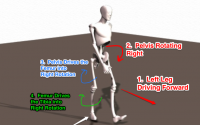Gravity and Ground Reaction Force
I don’t remember these two being mentioned prior to my studies with John Hardy, Gary Gray and Dr David Tiberio. They are the ones who introduced this way of thinking to me and I don’t know why, but I knew it was a game changer!
It wasn’t just this principle that changed things, but the fact that my eyes were opened to this way of thinking. I’d like to think I would have come to some of these conclusions eventually anyway…but I might not have and it may have taken forever! So I feel lucky to have been introduced to them so early in my career.
Gravity
It does seem a little obvious that this would be important, but it’s worth looking at. The question I was asked about it was ‘in function, what bends the knee?’ Clearly, the answer in most cases is GRAVITY! However, I’m sure I would have said the hamstrings…not really wrong, but is crucially not a useful way to think of movement in function.
If you are standing you aren’t actively flexing the knees as you squat, as you squat down you are simply avoiding crumpling to the ground and controlling the decent. In essence the knee flexion is given for free. Gravity is a driver of motion, it’s pretty consistent! Learning to take advantage of this changes your view of exercise and how create the reactions you want.
The paradigm shift is to change from thinking how to make the muscle work, but think about how to make the muscle react. This will bring you far closer to function and all of a sudden you see your exercises looking a lot more like everyday movements.
Ground Reaction Force
If gravity is the force that acts with static exercises like squats, then ground reaction force (GRF) is the force that acts as a multiplier of gravity when your body hits the ground in movements like lunges, walking, jumping, etc.
In a simple exercise like a squat, roughly 1 times body weight has to be dealt with. If you then look at landing from a jump, which is very similar, but increases the forces involved to multiple times body weight (depending on how high you are landing from of course).
This is great news for those in the market for creating they’re own exercises. You can manipulate this force to make exercises more or less challenging depending on your patients ability, condition, stage of injury, etc. For example, if a football player returning from a syndesmosis stabilisation is 2 weeks post op you are going to keep the forces low. They might be very static based exercises. However, if you want them to have a successful return to play, then increasing the forces they have to control is key and that is where GRF is so useful.
I remember learning about what happens when the foot hits the floor in gait as my first exposure to the power of GRF. The body using the forces imposed on it to create forward motion, which in most people looks effortless. The movement of robots rarely looks effortless, probably because they are creating the force to move and not reacting to the forces and turning them into movement.
Summary
In the traditional view of the body and it’s function it is true to say that the hamstrings, gastocs etc flex the knee. Though of course this isn’t wrong, it’s just we are not robots…joints aren’t flexed and extended by the muscles to claw our way across the ground! That is why movement is so interesting, it’s almost like magic 🙂
My point here is rather than a mechanical view of the body, we need to see how the body uses the forces that act on it and transfer it into motion. This is so powerful in therapy as it aligns very nicely with a more holistic approach to therapy.
Learn about the forces that act upon us, learn how to take advantage of them and you will love your success with movement therapy and exercise.
Physioblogger


